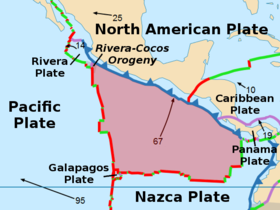Cocos Plate
| Cocos Plate | |
|---|---|
 | |
| Type | Minor |
| Approximate area | 2,900,000 km2[1] |
| Movement1 | north-east |
| Speed1 | 67 mm/year |
| Features | Cocos Island,Pacific Ocean |
| 1Relative to theAfrican Plate | |
TheCocos Plateis a young oceanictectonic platebeneath thePacific Oceanoff the west coast ofCentral America,named forCocos Island,which rides upon it. The Cocos Plate was created approximately 23 million years ago when theFarallon Platebroke into two pieces, which also created theNazca Plate.The Cocos Plate also broke into two pieces, creating the smallRivera Plate.[2]The Cocos Plate is bounded by several different plates. To the northeast it is bounded by theNorth American Plateand theCaribbean Plate.To the west it is bounded by thePacific Plateand to the south by theNazca Plate.
The only land above water on the Cocos Plate isCocos Island,which is administered byCosta Ricaand lies approximately 550 km (342 mi; 297 nmi) southwest of the Costa Rican mainland.
Geology
[edit]The Cocos Plate was created bysea floor spreadingalong theEast Pacific Riseand theCocos Ridge,specifically in a complicated area geologists call the Cocos-Nazca spreading system. From the rise the plate is pushed eastward and pushed or dragged (perhaps both) under the less denseCaribbean Plate,in the process calledsubduction.The subducted leading edge heats up and adds its water to the mantle above it. In the mantle layer called theasthenosphere,mantle rock melts to makemagma,trappingsuperheated waterunder great pressure. As a result, to the northeast of the subducting edge lies the continuous arc ofvolcanos—also known as theCentral America Volcanic Arc— stretching fromCosta RicatoGuatemala,and a belt of earthquakes that extends farther north, intoMexico.
The northern boundary of the Cocos Plate is theMiddle America Trench.The eastern boundary is atransform fault,thePanama Fracture Zone.The southern boundary is amid-oceanic ridge,theGalapagos Rise.[3]The western boundary is another mid-ocean ridge, theEast Pacific Rise.
Ahotspotunder theGalapagos Islandslies along the Galapagos Rise. (seeGalapagos hotspotandGalapagos Microplate)
TheRivera Platenorth of the Cocos Plate is thought to have separated from the Cocos Plate 5–10 million years ago. The boundary between the two plates appears to lack a definitetransform fault,yet they are regarded as distinct. After its separation from the Cocos Plate, the Rivera Plate started acting as an independent microplate.[2]
The devastating1985 Mexico City earthquakeand the2017 Chiapas earthquakewere results of the subduction of the Cocos Plate beneath theNorth American Plate.The devastating El Salvador earthquakes inJanuary 2001andFebruary 2001were generated by the subduction of this plate beneath theCaribbean Plate.
References
[edit]- ^"Here are the Sizes of Tectonic or Lithospheric Plates".Archived fromthe originalon 2007-02-09.Retrieved2015-05-05.
- ^abManea, V.C.; Manea, M.; Ferarri, L. (2013)."A geodynamical perspective on the subduction of Cocos and Rivera plates beneath Mexico and Central America"(PDF).Tectonophysics.609:56–81.Bibcode:2013Tectp.609...56M.doi:10.1016/j.tecto.2012.12.039.Retrieved24 April2017.[permanent dead link]
- ^Paul J. Grim, "Connection of the Panama fracture zone with the Galapagos rift zone, eastern tropical Pacific".
External links
[edit]- The volcanic arc
- Martin Meschede and Udo Barckhausen, "Plate tectonic evolution of the Cocos-Nazca plate":reconstructing its geological evolution

